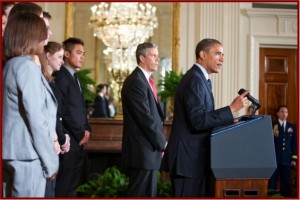
President Barack Obama, with Education Secretary Arne Duncan, delivers a statement on college affordability and interest rates on student loans, in the East Room of the White House.
A new report released today by the U.S. Department of the Treasury and the U.S. Department of Education looks at the economic case for higher education. The election year maneuvering comes as President Obama calls on Congress to keep interest rates low for the 7.4 million borrowers who are expected to take out subsidized Federal student loans next year.
Federal financial aid now represents 55% of all assistance to undergraduates at two- and four-year institutions. Auto companies are struggling to hire engineers, particularly in electronics and telematics areas since enrollments dropped off during the Great Recession.
The taxpayer subsidies and high delinquent rates of the current program, along with an unsustainable national debt have the program under attack by Republicans hoping to regain power this fall. Without Congressional action, interest rates on new subsidized loans will double, increasing from 3.4% to 6.8% starting in July 2012. Nothing is being done to reign in higher education costs by President Obama, who has strong backing from teachers unions.
The data and analysis say that higher education is critical for “socioeconomic advancement” and an important driver of economic mobility. As bloated state budgets an under funded pension plans have repeatedly come under attack for their detachment from the new fiscal reality of less revenue, state support for higher education has declined. This has created a demand by students and their families for education grants and loans through Federal aid, even though the national budget is deeply in the red. Because the Federal government cannot address this issue alone, the President has also called on states and colleges to accept “shared responsibility” for college affordability. Thus far the rhetoric without substantive action it has resulted in a political stand off.
There is evidence that education raises earnings. The median weekly earnings for a full-time, full-year bachelor’s degree holder in 2011 was 64% higher than those for a high school graduate at $1,053 compared to $638.
This earnings differential grew steadily through the 1980s and 1990s. Recent data suggests that today’s earnings gap is the highest it has been since 1915, the earliest year for which there are estimates of the so called college wage gap.
Lacking a degree, children born to parents in the bottom income quintile have a 45% chance of remaining there as adults. With a degree, they have less than a 20% chance of staying in the bottom quintile of the income distribution.

